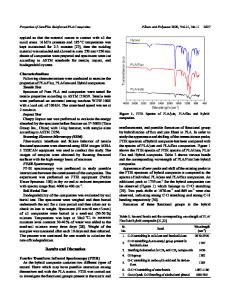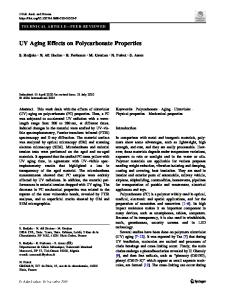A Study on Mechanical Properties of CNT Reinforced Carbon/Carbon Composites under Environment Aging Effects
- PDF / 728,923 Bytes
- 6 Pages / 595.22 x 842 pts (A4) Page_size
- 28 Downloads / 459 Views
A Study on Mechanical Properties of CNT Reinforced Carbon/Carbon Composites under Environment Aging Effects 1,3
Ming-Yuan Shen , Yi-Luen Li1, Huang-Suo Su1, Chin-Lung Chiang2, Yao- Kuei Hsiao3, Ming- Hsien Sung3, Ming-Chuen Yip1* 1
Department of Power Mechanical Engineering, National Tsing Hua University, Hsinchu, Taiwan, R.O.C. Department of Safety, Health and Environmental Engineering, Hung-Kuang University, Taichung,Taiwan 3 Plastic Industry Development Center, Taichung, Taiwan, R.O.C.
2
e-mail:[email protected]
ABSTRACT Carbon/carbon composites (C/C composites) possess superior characteristics of low density, high strength, extremely low coefficient of thermal expansion, high fatigue resistance. In carbonization process, the high temperature pyrolysis made of carbon, hydrogen, oxygen and other elements, results in a lot of voids and cavities generated in the interior of C/C composites. Therefore, the C/C composites are densified to fill the void by using repeated impregnation. But densification is a time-wasting and complex process, which increases production costs in the manufacturing process. In this study, the Multi-Wall Carbon Nanotubes (MWNTs) were adopted as reinforcement material for C/C composites to reduce the existence of voids or cavities and enhance the mechanical properties of C/C composites under environment aging effects. Three different temperature with high moisture conditions are used to be tested, including high temperature (150℃/ 90%RH), room temperature (25℃/90%RH), and low temperature (-15℃/90%RH) to analyze the mechanical properties of C/C composites, such as flexural and Interlaminar Shear Strength (ILSS). INTRODUCTION The advantage of carbon/carbon composite made of carbon fiber-reinforced carbon matrix includs high-temperature and high elastic coefficient, low density, low thermal-expansion coefficient and high fatique resistance[1-3]. Because of high aspect ratio[4], low density, high strength and high Young’s modulus carbon nanotubes (CNTs) possess, CNTs is regarded as the most suitable reinforcement material to interfuse into composites.Two difficulties occured while CNTs were interfused into composites. Both difficulties are described as follows: The first difficulty is low interfacial strength between CNT and polymer matrix[5] ; The second difficulty we met is that CNTs are hard to be evenly dispersed among matrix or risin[6]. These two difficulties must be solved first, than the superior properties of CNTs can be displayed to act as reinforcement material. In this study, the various content and amount of CNTs were tried to evenly dispersed among phenolic resin[7][8], and the phenolic resin solution with great CNTs dispersion was also evenly premeated through the carbon fiber cloth to prevent porous formation among the matrix during carbonization process and make CNTs effectively deliver stress[9][10]. The above-mentioned process not only can prevent porous generation among the matrix during carbonization process but also make CNTs effectively deliver stress to properly re
Data Loading...











